New theory links serpent mound cults, impact craters and high science
Top image: The Great Serpent Mound in Ohio, USA.
Within the lush Ohio River Valley lies the famous Serpent Mound effigy. It is an earthen mound aligned with the solstices, which rests on the ridge of a meteorite impact crater. This ancient, spellbinding effigy has been the subject of controversy and fascination, but what is so often overlooked, is the fact that this seemingly serpentine mound is not one of a kind. Two more (known) mounds exist, Serpent Mound Park in Ontario Canada (which has been closed since 2009), and Loch Nell Serpent Mound in Scotland.
The Canadian and Scottish earthworks are now mostly obscured from view, overgrown by vegetation, falling into ruin. But all of these mounds have been explored, excavated, and documented.
The existence of three, equally enigmatic effigies, even existing on separate continents, is a problem for mainstream historians. A problem, that has never remotely been addressed.
If the Native American Cultures of prehistoric North America were responsible for the construction of these mounds, how can it be then, that a virtually identical earthwork exists in Scotland?
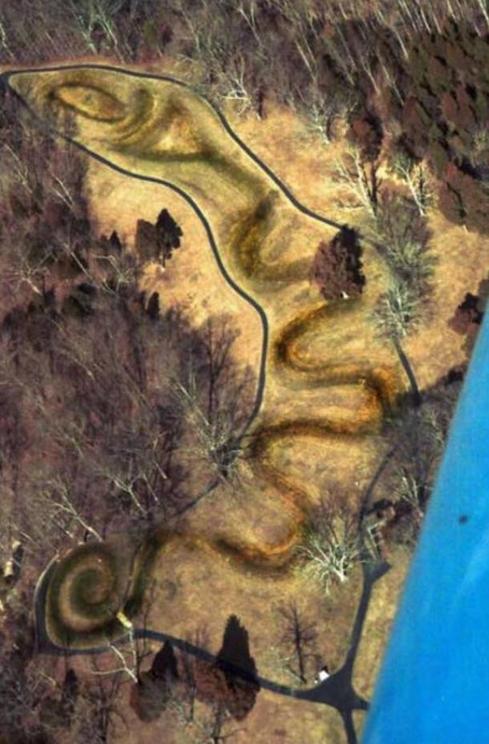 View of the Great Serpent Mound, one of the most important prehistoric effigy mounds of Adema Culture, located on the Ohio River, Ohio, USA.
View of the Great Serpent Mound, one of the most important prehistoric effigy mounds of Adema Culture, located on the Ohio River, Ohio, USA.
First A Word On Serpent Mounds And Craters
Erecting three dimensional, seemingly serpentine, effigy Serpent mounds is not something agrarian or hunter-gatherer human beings are whimsically compelled to do, despite feeble theories to the contrary. As if this were not a substantial problem by itself, there is another.
All of these Serpent mounds are in close proximity to impact craters that are millions of years old. These impact craters are not easily identifiable and would have been virtually impossible to identify by whomever these ancients were.
When an asteroid impacts the surface of the Earth, it can potentially have profound ecological effects on the entire planet. For instance, it has been widely theorized and accepted by paleontologists that most likely a massive impact event was what caused the demise of the dinosaurs.
There is a pattern of ancient symbolism, solar significance, and mound construction interwoven with these impact craters. Furthermore, the ancients who made these mounds must have somehow been aware of the unique geological significance of these sites. And it was for this reason, that they regarded these patches of land as sacred, erecting ceremonial sites, and consecrating them as places of reverence.
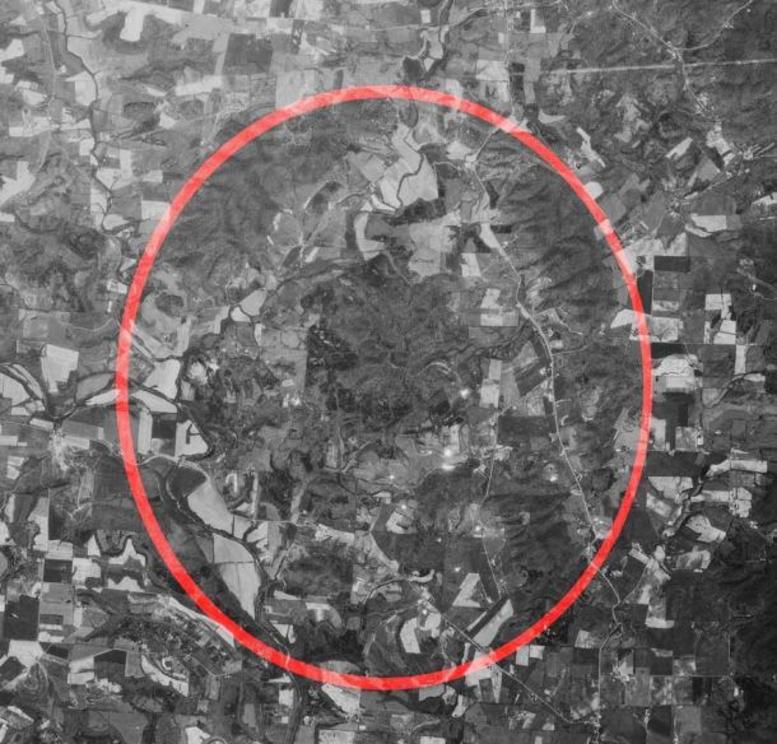 Aerial photo of Ohio's Serpent Mound crater, with the red oval showing the approximate perimeter according to K. Milam, 2010. Photo taken in 1974.
Aerial photo of Ohio's Serpent Mound crater, with the red oval showing the approximate perimeter according to K. Milam, 2010. Photo taken in 1974.
The Ohio Impact Crater
The Serpent Mound Crater or the Serpent Mound Disturbance is a complex, eroded, meteorite crater in Adams County, Ohio. The maximum rim diameter of the crater is 8.7 miles (14 km), and it is estimated to be less than 320 million years old.
Features of the geological structure include a ring graben, a central uplift, and a transitional zone. Although they were unaware of the bigger geological picture, early European explorers made note of the unusual geographic features and did suggest that the unique geology of the region may have inspired the early inhabitants of the area to build so many effigy and burial mounds.
Keep in mind, the Serpent Mound is not the only ancient earthworks in the region. The entire Great Lakes and Ohio River Valley regions were filled to the brim with effigy and burial mounds.
The Ontario Mound Culture
Serpent Mounds Park used to be a historical and recreational park located in Keene, Ontario, Canada. The park was abruptly closed in 2009. Its name comes from the Serpent effigy and burial mounds within the site.
Archaeological excavations attributed the earthworks to a culture they decided to call the “Point Peninsula Complex.” Their conclusion was that the habitation and construction of the site occurred around 2000 years ago during the prehistoric Middle Woodland period .
The Middle Woodland culture raises significant questions within the archaeological record due to their presentation of some head-scratching anomalies. For example, they possessed an advanced form of pottery. This superior pottery suddenly appeared and the origins of it are uncertain. Also, within their mound burials, exotic grave goods were discovered. Copper objects mined from Lake Superior were found, along with obsidian goods which originated near the Yellowstone area, and most interestingly, seashells from the Gulf Coast region.
Silver panpipes have also been discovered in burial mounds in both Canada and the Ohio River Valley, and the raw materials for these objects came from Cobalt, Ontario, which is problematic due to Cobalt’s far northern location.
Mainstream archaeologists interpret all this to indicate a vast trade network, but the problem is, that these artifacts suddenly emerged around 200 BC, then just as suddenly, vanished around 400 AD.
 Ground plan of Otonabee Serpent Mound, Ontario, Canada.
Ground plan of Otonabee Serpent Mound, Ontario, Canada.
The Ontario Impact Crater
The Holleford Crater is a 550-100-million-year-old meteor crater in Holleford, Ontario, just a stone’s throw from Serpent Mounds Park. The landscape of the area is depressed, which is what led geologists to discover the crater, but despite the depression, the crater itself is not visible at the surface.
The crater was only confirmed in the 1950s, when a series of geophysical studies and aerial photography sessions were conducted by the Geological Survey of Canada and the Dominion Observatory of Ottawa. They determined the approximate age of the crater along with its diameter of about 1.5 miles (2.35km).
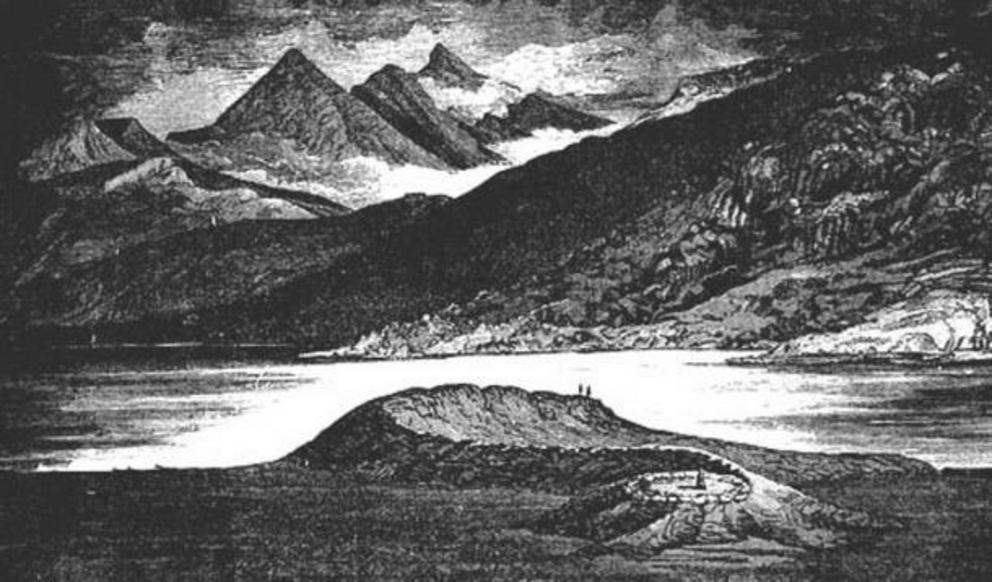 Drawing of Scotland's Loch Nell Serpent Mound, from Constance F Gordon-Cumming’s book “In the Hebrides.”
Drawing of Scotland's Loch Nell Serpent Mound, from Constance F Gordon-Cumming’s book “In the Hebrides.”
Scotland’s Loch Nell Serpent Mound Across The Atlantic
All three serpent mounds seem to be veiled under archaeological secrecy, but Loch Nell Serpent Mound is the most obscure of the trio. Thanks to the dedicated work of Earth mystery enthusiast, and fellow Ancient Origins colleague Andrew Collins, some information is available online.
Collins sums up the early explorations/documentations of the effigy mound nicely:
It was explored in 1871 by Mr. JS Phene, FSA, who determined through excavation that at its western extremity, identified as the serpent's 'head', was a cairn of stones beneath which were 'three large stones forming a megalithic chamber, which contained burnt bones, charcoal, and burnt hazel-nuts,' as well as a flint implement.
Just one year later, the structure was visited by travel writer and painter Constance Gordon Cumming, who gave an account of it in a work entitled “ Good Words, ” published in 1872, and again in her book In the Hebrides , published in 1883. In these works, she describes the monument as:
a huge serpent-shaped mound,” as well as “a very remarkable object, and one, moreover, which rises conspicuously from the flat grassy plain, that stretches for some distance on either side, with scarcely an undulation, save two artificial circular mounds, in one of which lie several large stones, forming a cromlech. These circles are situated a short distance to the south, to the right of the Reptile.
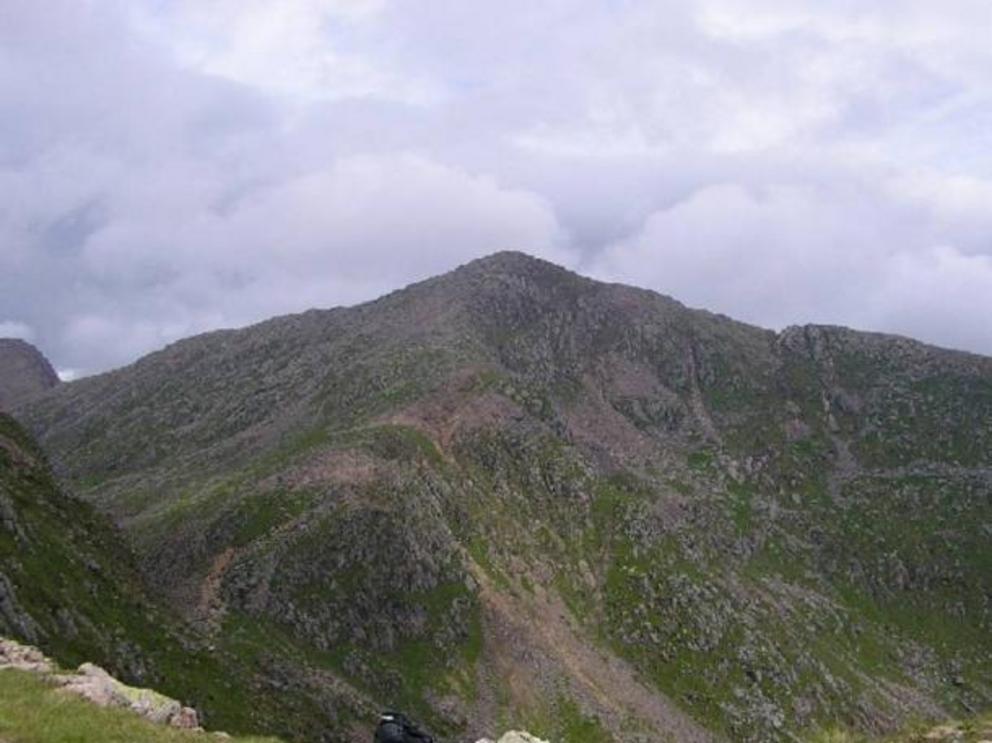 The sacred Ben Cruachan in Scotland, seen from Meall Cunanail.
The sacred Ben Cruachan in Scotland, seen from Meall Cunanail.
The Loch Nell Serpent Mound Continued
Collins, drawing from the works of Phene and Cumming, goes on to report on the remnants of what may have originally been a ceremonial altar , which seems to have been deliberately aligned with three, nearby mountain peaks.
“The mound was built in such a manner that the worshipper, standing at the altar, 'would naturally look eastward, directly along the whole length of the great reptile, and across the dark lake, to the triple peaks of Ben Cruachan. This position must have been carefully selected, as from no other point are the three peaks visible.' The Ben Cruachan are sacred mountains associated in legend with the Cailleach Bheur, the old hag of the mountains, while the serpent mound itself was once said to be the burial place of the Scottish folk-hero Ossian, son of Fingal. The Cailleach Bheur is considered the dark half of the Irish and British goddess Brigid, whose principal zoomorphic symbols are the serpent and swan, reflecting the root of Loch Nell's name and the presence on its shores of the serpent mound.”
The Hidden Impact Crater of Scotland
According to modern geology experts, along the west coast of Scotland, unique geological material (known as the Stac Fada Member deposits) have long been mistakenly attributed to volcanic activity, but instead are a blanket of material generated by an impact event in distant epochs past.
This discovery came in 2006, when Oxford PhD candidate Ken Amor found shards of shocked quartz , which prove that the site was formed by a space rock slamming into the Earth. Currently, Amor is competing in a scientific race of sorts with rival geologists to prove their theories of where exactly this crater rests, hidden under millions of years of sediment.
They are in the process of surveying sites to drill, while others are very interested in studying a 25-mile-wide (40-kwide) magnetic anomaly known as the Lairg Gravity Low. But as of this moment, neither faction has been able to locate the crater, although the scientific community universally agrees there must be one. Perhaps they should look to the south near Loch Nell?
 The self-constricting magnetic field lines and current paths in a Birkeland current.
The self-constricting magnetic field lines and current paths in a Birkeland current.
Scientific Serpent Symbolism?
Magnetic and or electromagnetic anomalies associated with impact craters is well established science. But what is not at all established is how this may relate to ancient serpent symbolism .
Mainstream academics in the field of religious iconography have long known that there is a connection to serpent symbolism and energy currents . Even the casual observer or grade school science student can make the observation that the locomotion and basic form of a snake is similar to that of an energy or sound wave. This is of course, more than just a physical similarity, but also a governing dynamic of how physical objects travel though air, water, or even outer space.
A Birkeland current (named after physicist/explorer Kristian Birkeland) can be defined as a set of currents that flow along geomagnetic lines, linking the Earth’s magnetosphere to its high latitude ionosphere. When these currents (which originate from the sun/solar winds) are diagramed, or visibly observed by high technology, their physical form is a self-constricting wave that emanates snakelike magnetic field spirals.
It seems an impossible coincidence that these craters with their magnetic anomalies just happen to have very similar symbols erected near them, which are aligned towards the sun (the origin of such currents). It is also noteworthy on this point, that the best preserved, most visible of the mounds in Ohio, still has both the “serpentine/wave/current” symbol, and the spiral (or magnetic field) symbol emanating from it. And while it may no longer be visible, the Cummings illustration from 1883 AD depicts this feature as well.
 A sperm hologram reveals another dimension of the Serpent mound effigies.
A sperm hologram reveals another dimension of the Serpent mound effigies.
Science and Sperm Symbolism?
The theory of panspermia holds that life emerged elsewhere in the universe, through unspecified processes, and was then spread to planet Earth by a medium like an asteroid, space dust, a comet, or a meteorite.
Modern, definitive research has concluded that complex, organic molecules exist within interstellar space and within this solar system. It is quite probable then, that these fundamental building blocks of life arrived here by way of these mechanisms. This means that an impact crater could be a place from which all life originated on planet Earth. Worthy of reverence indeed.
Also, these serpent symbols may represent sperm, especially in the light of these connections to impact craters and the probability that microorganisms may have first arrived here in such a way. Added to that, is the frequency with which prehistoric cults focused on fertility as well. Once again, it might not be so much that they are depictions of serpents, sperm, or Birkeland currents specifically, but more so, a representation of a governing dynamic form within the natural world.
In a study published in 2015, the scientists touch on this in the abstract:
Locomotion and transport of microorganisms in fluids is an essential aspect of life. Search for food, orientation toward light, spreading of off-spring, and the formation of colonies are only possible due to locomotion. Prominent propulsion mechanisms are rotating helical flagella, exploited by many bacteria, and snake-like or whip-like motion of eukaryotic flagella, utilized by sperm and algae.
Moreover in regard to panspermia, if one imagines the Earth (which it has been argued is a sentient, feminine organism) as a womb or egg/ovum, and a space rock containing organic, microscopic life as a sperm, then an impact event very much does resemble the conception, fertilization, and zygote formation process.
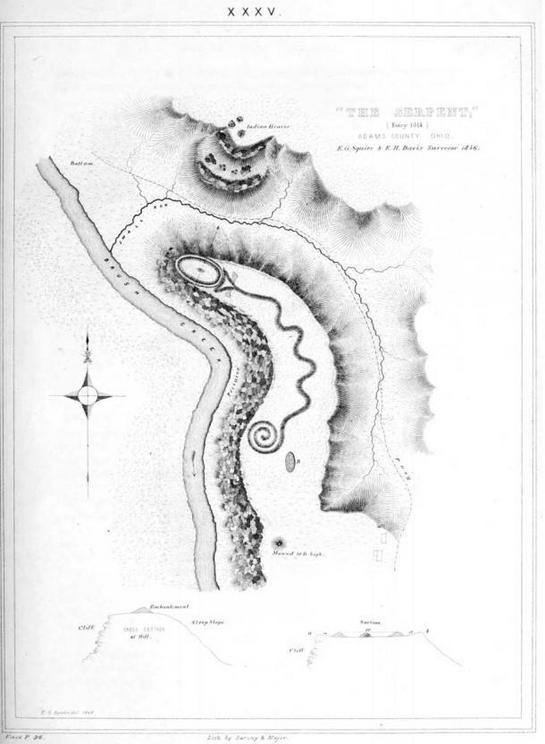 An old drawing of the Great Serpent Mound, Ohio.
An old drawing of the Great Serpent Mound, Ohio.
More Mounds, Craters, and Serpentine Symbols?
One, if not the most massive of impact craters, resides beneath the sea off the coast of Mexico’s Yucatan Peninsula. This is the impact event that paleontologists suspect wiped out the dinosaurs in what must have been an apocalyptic extinction event.
But what is most intriguing about this crater, in terms of the previously mentioned elements, is that the ancient Maya were compelled to build thousands upon thousands of pyramids on that peninsula. Pyramids, that are aligned towards the sun, and adorned with/dedicated to a serpentine-dragon creator deity.
Perhaps most fascinating of all these pyramids, is the Temple of Kukulkan within the ancient complex of Chichen Itza. This site sits right on the coast, pointing directly out towards the massive impact crater that has been submerged under the sea for millions of years
Most wonderous of all, is that the Temple of Kukulkan was engineered/aligned with such precision, that when the sun rises on the solstices, the stepped stone edges of the pyramid create a shadow of an undulating serpent, descending from the sky with its head touching the Earth.
 Chichen Itza Snake Head and Pyramid of Kukulcan on the edge of the Yucatan Peninsula, Mexico facing the sea.
Chichen Itza Snake Head and Pyramid of Kukulcan on the edge of the Yucatan Peninsula, Mexico facing the sea.
Conclusions
What conclusions can be drawn from this apparent linkage between high geophysical science, ancient serpent symbolism, and impact craters?
It can be reasonably concluded that there must have been some degree of cultural diffusion that remains unacknowledged by conventional theories of human history. There certainly were no Native Americans in Scotland, and yet, we find burial mounds and serpent effigies along with many other parallels throughout the Old World that go far beyond basic similarities common to all cultures.
Also, it can be objectively gleaned that there is a much greater depth of knowledge contained within ancient symbolism and paradigms than has been realized by the mainstream academic community.
There is a certain ancient, Arabic proverb that comes to mind from Apollonius of Tyana’s Secret of Creation, or the alchemists’ Emerald Tablet , and although it has been severely abused by new age charlatans, it seems irresistibly apt: “That which is above is from that which is below, and that which is below is from that which is above.”

